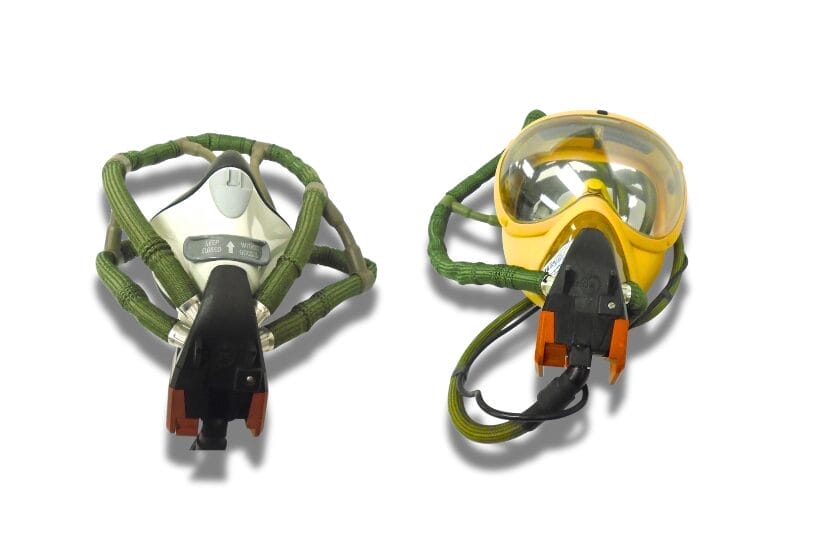When cabin pressure drops during flight, the yellow oxygen masks above your seat become life-saving devices. Due to their importance is the event of pressure dropping, it’s important to know how to understand proper airplane oxygen mask instructions. This knowledge could make the difference between staying conscious and passing out at 30,000 feet.
Let’s walk through everything you need to know about these critical safety components.

What is an Airplane Oxygen Mask?
An airplane oxygen mask is a yellow plastic cup connected to an oxygen supply system through flexible tubing. These masks automatically deploy from overhead compartments when cabin pressure drops below safe levels. Each mask contains a simple valve system and an elastic strap designed to secure the device over your nose and mouth during an emergency. This safety feature highlights how airplane cabin pressurization works hand-in-hand with emergency systems to keep passengers protected.
The oxygen mask connects to generators that produce oxygen through a chemical reaction, ensuring passengers receive breathable air even when the airplane cabin loses pressurization at high altitude.
What Are They Used For and Why Are They Important?
Oxygen masks serve one critical purpose: keeping you conscious during rapid decompression events. When cabin pressure fails, the thin air at cruising altitude contains insufficient oxygen to sustain consciousness for more than 15-30 seconds.
These masks provide the essential oxygen supply needed to prevent hypoxia—a dangerous condition where your brain doesn’t receive adequate oxygen. Without proper oxygen flow, passengers would quickly lose consciousness, making evacuation and emergency procedures impossible.
The importance of oxygen masks becomes clear when you consider that commercial aircraft typically cruise between 30,000 and 40,000 feet, where the natural atmosphere contains only about 25% of the oxygen available at sea level.

When Are They Released to Passengers?
Oxygen masks deploy automatically when cabin pressure drops to approximately 14,000 feet equivalent altitude. This threshold ensures masks become available before passengers experience serious oxygen deprivation symptoms.
Several scenarios trigger automatic deployment:
- Rapid decompression due to structural damage
- Gradual pressure loss from system failures
- Emergency descent procedures initiated by pilots
Flight attendants can also manually release oxygen masks if they observe signs of cabin pressure problems before automatic systems activate. The deployment happens instantly across all passenger areas simultaneously, accompanied by audible warnings and emergency lighting.
How Do They Work?
The oxygen mask system operates through chemical oxygen generators rather than pressurized tanks. When masks deploy, pulling the mask toward your face activates these generators through a simple pin-pull mechanism.
Once activated, the chemical reaction produces oxygen for approximately 12-15 minutes—sufficient time for pilots to descend to a safe altitude where normal breathing resumes. The plastic bag attached to your mask may not fully inflate during use, which is completely normal and doesn’t indicate a malfunction.
The oxygen flow rate adjusts automatically based on cabin conditions, delivering the precise amount needed to maintain consciousness and cognitive function during the emergency descent.

Step-by-Step Oxygen Mask Instructions
1. Remain Calm and Act Quickly
When masks drop, you have less than 30 seconds before potential unconsciousness at high altitude. Don’t panic. Move with purpose. Avoid fumbling with personal items or checking on others immediately. Your priority is securing your own oxygen mask first.
2. Pull the Mask Toward You
Grab the nearest oxygen mask and pull it firmly toward your face. This pulling motion activates the oxygen generator, starting the chemical reaction that produces breathable air. The mask closest to you may not be directly overhead. Choose whichever mask you can reach most easily.
3. Place the Mask Over Your Nose and Mouth
Cover both your nose and mouth completely with the yellow cup. The mask should create a seal around these areas to prevent oxygen loss. Don’t worry about perfect positioning initially; getting oxygen flowing is more important than minor adjustments.
4. Secure the Elastic Strap
Pull the elastic strap over your head and adjust for a snug but comfortable fit. The strap should hold the mask firmly against your face without causing pain or completely cutting off circulation. A properly secured mask won’t slip off during aircraft movement.
5. Breathe Normally
Once your own mask is secure, breathe normally through both your nose and mouth. Don’t try to conserve oxygen by taking shallow breaths. The system provides adequate flow for normal respiration patterns. Deep, regular breathing helps maintain optimal oxygen levels.
6. Assist Others After Securing Your Own Mask
Only after your own oxygen mask is properly fitted should you help others around you. This sequence isn’t selfish—it’s practical safety. You cannot effectively care for others if you lose consciousness from oxygen deprivation.
Help children, elderly passengers, or anyone having difficulty with their masks. Flight attendants will coordinate overall passenger assistance, but immediate neighbors should help each other once their personal safety is secured.
7. Keep the Mask On Until Instructed Otherwise
Continue wearing your oxygen mask until flight attendants or pilots announce it’s safe to remove it. This typically occurs after the aircraft descends below 10,000 feet, where natural cabin air contains sufficient oxygen for normal breathing.
Don’t remove your mask prematurely, even if you feel fine. Oxygen deprivation symptoms can be subtle, and maintaining the oxygen supply ensures you remain alert for any additional emergency procedures.

Your Lifeline at 30,000 Feet
Knowing these airplane oxygen mask instructions prepares you for the rare but serious event of an emergency decompression. While cabin pressure failures are uncommon, knowing how to respond quickly and correctly can save your life and the lives of others around you.
The golden rule remains simple: secure your own mask first, then help others. It’s not selfish. It’s practical safety that makes sure you remain conscious and capable of providing care to others when they need it most.
